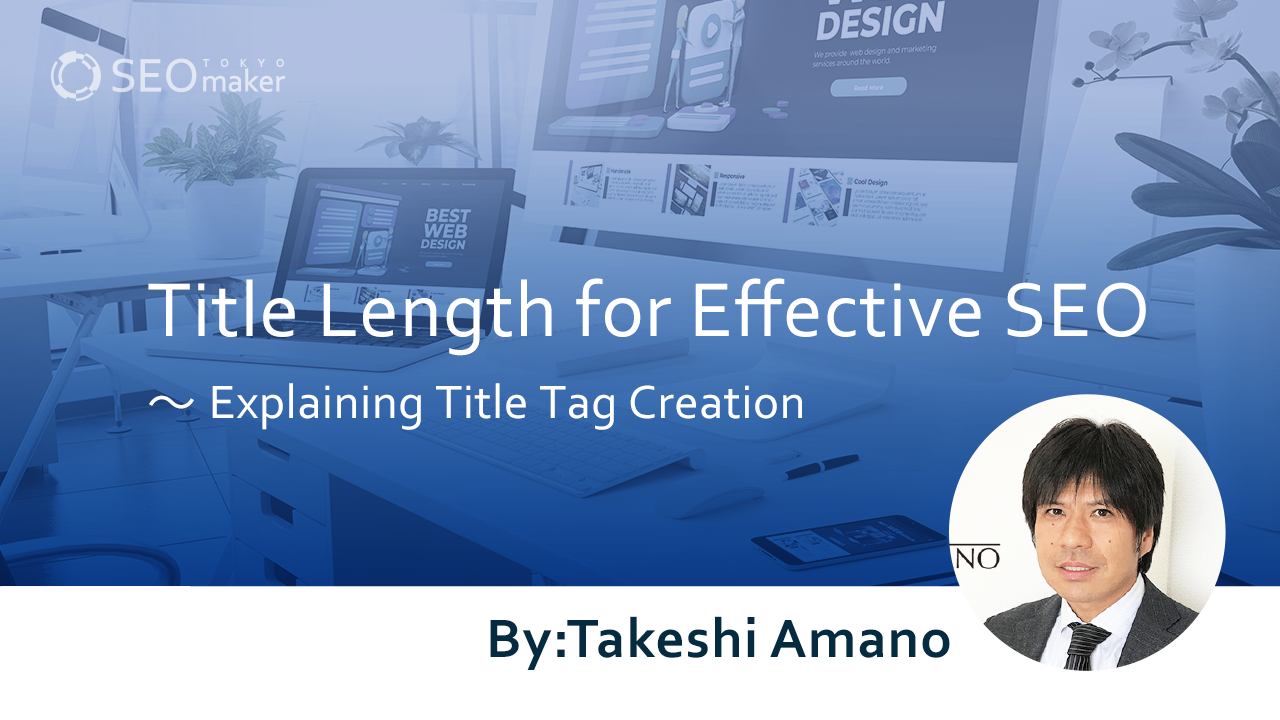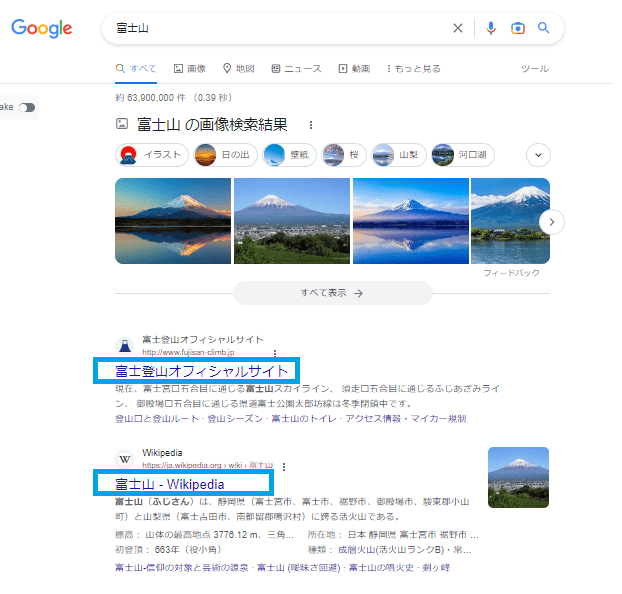Title Length for Effective SEO~Explaining Title Tag Creation
contents
- 1 Basic SEO Strategy‐Understanding Titles
- 2 The Importance of Titles in SEO
- 2.1 Influencing Search Rankings
- 2.2 Impacting Click-Through Rates
- 2.3 Becoming Anchor Texts
- 2.4 Crafting Effective Titles for SEO
- 2.5 Aligning Titles with Page Content
- 2.6 Incorporating Keywords
- 2.7 Avoid Using Irrelevant Keywords
- 2.8 Ensure Uniqueness Across All Pages
- 2.9 Title Length Should Be Around 30 Characters
- 2.10 Place Keywords at the Beginning
- 2.11 Avoid Repeating the Same Keyword
- 2.12 Exact Matches Are Stronger
- 3 Differentiation Tips for Creating Titles that Stand Out from Competitors
- 4 Common Misconceptions about SEO and Titles
- 5 Common Questions About SEO and Titles
 In Search Engine Optimization (SEO), titles are a critical component. They serve as significant clues for search engines like Google to understand the content and theme of a page.
In Search Engine Optimization (SEO), titles are a critical component. They serve as significant clues for search engines like Google to understand the content and theme of a page.
As implementing SEO strategies, you might often wonder about what content should be included in the title and how long it should be. In this article, we will explain in detail how to create effective titles for SEO.
Basic SEO Strategy‐Understanding Titles
A title is the text displayed in search results and at the top of a browser.
For example, if you search for “Mount Fuji” on Google, you’ll see results like “Mount Fuji Official Site” or “Mount Fuji – Wikipedia.” These are examples of titles.

Despite HTML tags having a reduced impact on SEO lately, search engines continue to prioritize title tags.
Titles are also crucial for search users, as they decide whether to click on a webpage based on its title. Therefore, web managers and copywriters should thoughtfully create optimal titles.
Writing Title Tags
In HTML or XML markup languages, tags are symbols used to indicate elements or attributes. For titles, the “” tag is used.
However, when using title tags, they need to be placed within the head tag as follows:
<head>
<title>Enter Title Here</title>
</head>
Title tags typically contain text summarizing the web page’s content, which search engines analyze to understand the page’s theme and content.
The Importance of Titles in SEO
Titles are vital in SEO for the following three reasons:
- They affect search rankings.
- They influence click-through rates.
- They often become anchor texts.
American SEO company Moz also points out the importance of choosing the right title for both search engines and users. Let’s discuss these points in more detail.
Reference Page: Title Tag – Moz
Influencing Search Rankings
Titles are crucial in accurately conveying the theme and content of a web page to search engines. Search engines analyze the keywords and content within the title to determine the theme of the web page. Thus, setting an appropriate title is a fundamental aspect of SEO.
Impacting Click-Through Rates
The information in the title tag is displayed directly in search results. Therefore, users decide whether to click on a web page based on the title they see in the search results. An attractive title can lead to a higher click-through rate, while a title that seems less relevant to user needs may result in a lower rate.
Even slight variations in click-through rates can significantly affect the number of visits to a website, especially for keywords with high search volumes.
A title can be compared to the spine of a book. When choosing from a vast array of books in a bookstore or library, one naturally selects books that seem to meet their needs. It’s impractical to read every book to make a decision, so most people make their choice based on the book’s spine.
Considering this, it’s evident that effective titling is crucial not only for SEO but also for broader marketing purposes.
Becoming Anchor Texts
Titles are frequently used as anchor texts when sharing links on social media platforms like Twitter, Facebook, and on blogs such as Hatena.
An intriguing title accompanied by an image can spontaneously attract clicks, particularly on social media where buzz marketing — a strategy to generate word-of-mouth artificially — plays a significant role.
In many cases, the title of the link becomes the anchor text, thus enhancing the SEO benefits of receiving backlinks.
Anchor texts can be checked through the Links menu in Google Search Console. This tool allows you to see how your site is being referenced.
Unlike in the past, SEO specialists must now focus not only on content but also on social media.
The title and image of a site are key elements when disseminating information on social media. High-quality content can attract traffic from both search engines and social media platforms.
Crafting Effective Titles for SEO
The most crucial aspect when creating a title is ensuring it aligns with the content of the article. If a user clicks on a title and finds content that is entirely different, it leads to dissatisfaction and potentially increased bounce rates.
Choosing the right title can be challenging, but please adhere to the following eight principles:
- Ensure the title and page content match.
- Include relevant keywords.
- Avoid using keywords that are not closely related.
- Make each page title unique.
- Keep the title around 30 characters in length.
- Place keywords towards the beginning of the title.
- Avoid repeated use of the same keyword.
- Exact keyword matches are more effective.
Aligning Titles with Page Content
The most crucial factor is to ensure that the title reflects the content of the page.
When focusing on SEO, you might write comprehensive, lengthy content, but within it, there should be core information. If there’s no central information or if there are multiple core points, you might need to consider rewriting or splitting the content. The title should encapsulate the essence of the content.
Often, you may see the practice of deciding on a title before creating the content. However, the more appropriate approach would be to create the content first, then review it and decide on a title that best captures its core message.
Incorporating Keywords
When advancing content SEO, it’s imperative that each piece of content is associated with one specific keyword. This keyword must be included in the title.
There can be instances where multiple targeted keywords are applicable. For medium-tail keywords, two words might be used, and for short-tail keywords, it could be two, three, or four words. Ensure that all these are included.
For example, a good title would be ‘How to Choose a Wristwatch.’ This title is concise and includes the keyword clearly. While it’s okay to elaborate to make the content more understandable, this title is sufficient in terms of communication. Conversely, a less effective title would be ‘The Method to Acquire the Ideal Wristwatch.’ Although it might mean the same, it’s less clear and harder to understand.
After the 2019 BERT (Bidirectional Encoder Representations from Transformers) update, it has been noted that web pages can rank high in search results without explicitly using the exact keywords. This is due to improved search engine algorithms that understand the meaning of words and reflect this in search results. Therefore, it is possible to rank high even without using specific keywords if the content conveys the same meaning.
However, including targeted keywords still tends to be more effective, and aiming for a high ranking without using keywords can be more challenging and is not generally recommended.
Avoid Using Irrelevant Keywords
Please refrain from including keywords that are unrelated or only loosely related to the content. Incorporating multiple keywords can inadvertently shift away from the intended search purpose or alter the meaning.
Strive to be as concise as possible, including only necessary information.
For instance, a good title would be ‘How to Choose a Wristwatch | Focusing on Functionality, Brand, or Appearance.’ This title effectively includes keywords closely related to ‘choosing a wristwatch’ such as ‘functionality,’ ‘brand,’ and ‘appearance.’ On the other hand, a less effective title would be ‘How to Choose a Wristwatch | For Buying Furniture & Appliances, Visit Company XYZ.’
While this may not always negatively impact the content, keywords like ‘furniture’ and ‘appliances’ are unnecessary for content focused on ‘choosing a wristwatch.’ Although it’s common to include the company name at the end of a title, it’s more effective to consider the relevance and placement of such additions for each page.
Ensure Uniqueness Across All Pages
It is necessary to set a title for every page, but it is crucial that no two titles are the same. Each title should be unique.
Having identical titles across multiple pages can confuse search engines about which page to prioritize, leading to a dispersion of evaluation and potentially affecting the actual search ranking.
Although it’s rare to see identical titles used today, caution is needed for websites created more than 10 years ago that have never been updated or reviewed.
Title Length Should Be Around 30 Characters
There’s no strict limit on the number of characters for title tags, but ideally, they should be around 30 characters. This is because titles longer than this often get truncated in search results, appearing with an ellipsis (‘…’) after 30 characters. Users click based on the title, so it’s essential to convey the meaning within this character limit.
Google frequently changes its specifications, and the displayed character length of titles in search results can vary between desktop and mobile devices. Therefore, consider 30 characters as a guideline.
However, exceeding 30 characters does not necessarily result in a negative evaluation. The aim should be to create a title that communicates effectively to the user within this length.
Place Keywords at the Beginning
Putting the desired keywords at the beginning of the title has a dual purpose: targeting for SEO effectiveness and preventing truncation of text.
While the significant impact of this practice is currently debated, it’s generally believed that placing keywords at the beginning of the title can enhance SEO. However, this should be seen as a trend rather than a rule.
Long titles may get cut off, so placing keywords at the end might mean they go unseen by the user.
For example,
‘How to Choose a Wristwatch | Focusing on Functionality, Brand, or Appearance’
is a good title, while
‘Functionality, Brand, Appearance – Which to Prioritize?
How to Choose a Wristwatch’ may not be as effective. The arrangement can significantly change the impression and thus impact the click-through rate, so it’s preferable to place them at the beginning.
Avoid Repeating the Same Keyword
Since titles are typically around 30 characters, it’s unlikely that the same keyword will be used multiple times. There’s little benefit in repeating the same keyword, so keep it concise and natural.
However, using the same keyword two to three times does not necessarily lead to a negative evaluation (though more than three repetitions is not recommended).
For instance,
‘How to Choose a Wristwatch | Focusing on Functionality, Brand, or Appearance’ is a good example, whereas ‘How to Choose a Wristwatch | Functionality of Choosing a Wristwatch, Brand Selection’ is less effective.
Exact Matches Are Stronger
A subtle yet effective technique is that in the case of separated keywords, exact matches are stronger, and the closer the placement of the words, the better.
For example, ‘Affordable SEO Solutions by Tokyo SEO Maker’ is a good example, whereas ‘Affordable Rates for SEO Strategies at Tokyo SEO Maker’ is less effective.
The former has ‘Affordable’ and ‘SEO’ connected, whereas the latter has them separated. Where possible, maintain the integrity of the keyword phrase.
In the case of multi-word keywords, it’s also important to pay attention to their placement relative to each other. Although you cannot always connect them in a sentence, try to place them as close as possible.
Differentiation Tips for Creating Titles that Stand Out from Competitors
Here, we provide several tips on how to create titles that set you apart from your competitors.
Tailor to Your Target Audience
Creating a title that resonates with your target audience is crucial. Instead of solely focusing on search keywords, consider incorporating expressions and phrases that your existing customers commonly use into your titles.
Clearly Convey Benefits
While exaggeration should be avoided, it’s essential to clearly convey the benefits. Creating titles that are easy to understand can improve click-through rates compared to your competitors. Consider highlighting your company’s reliability and unique features in the title.
Focus on Problem Solving
Users often search for solutions to their problems. Therefore, create content that emphasizes problem-solving and reflect that in your titles. By doing so, you can provide users with valuable web pages and differentiate yourself from competitors.
Common Misconceptions about SEO and Titles
Titles play a significant role in SEO, making them one of the crucial elements. However, even web professionals often have misconceptions about titles. Here, we address some common points of confusion.
Titles Should Never Change Once Set
Many web professionals believe that once a title is set, it should never be changed. However, when the content or theme of a web page evolves, timely changes to the title are necessary. Periodically reviewing and adjusting titles can lead to improved click-through rates and higher search rankings. However, ensure that title changes align appropriately with the page’s content.
Shorter Is Always Better
While concise titles are generally advisable, excessively short titles can become unclear and lose their meaning. When writing titles, consider the importance of ensuring that users do not misunderstand and can accurately comprehend the content.
Extreme and Sensational Expressions Are Preferred
Using sensational language in titles may lead to a short-term increase in click-through rates. However, extreme expressions can diminish trust from users and search engines. Be cautious, as this can have a negative impact.
Reusing the Same Title
Assigning the same title to multiple pages is inappropriate. When search engines encounter multiple pages with identical titles, distinguishing between them becomes challenging. Therefore, it is essential to provide each page with a unique title.
Common Questions About SEO and Titles
In SEO, the title is a crucial point of focus. We have compiled a list of common questions for your reference.
Q: Will changing the title improve my search ranking?
A: If the original title was not appropriately set, correcting it can lead to improved rankings. We have observed numerous instances where sites that had never implemented any SEO measures saw a significant ranking improvement merely by altering their titles in accordance with our site’s internal audit recommendations.
However, if a site has already been optimized and the title was previously keyword-optimized, minor changes or adjustments are unlikely to significantly impact the ranking.
It’s important to note that search ranking is determined by a complex set of factors. Even if a change in title leads to a fluctuation in ranking, other potential reasons for this change could include Google’s algorithm updates, competitors updating their content, natural fluctuations in search rankings, or temporary spikes in popularity.
SEO is challenging because it’s not always clear if changes to a site directly influence ranking fluctuations.
Q: Why does the title displayed in search results change on its own?
A: Google may automatically modify titles. It reads the content and may adjust the title for display in search results. Often, Google’s changes are beneficial, but sometimes they may not align with the original intent, which can be problematic.
There is no guaranteed method to prevent these automatic changes. However, improving the title and content may help ensure that they are displayed as intended.
Excessive use of identical anchor texts for internal links can also lead to automatic title modifications. In such cases, it’s advisable to review your internal linking strategy.
Q: Can the title and H1 tags be the same?
A: While it’s acceptable for them to be identical, we recommend varying the keyword order or using different phrasing.
The title tag is used in search results and on social media, whereas the H1 tag is a heading within the content. Their purposes differ, but if their objectives are the same, matching them is acceptable. However, varying the phrasing is advisable.
Note that titles often include the company or service name, which is unnecessary in H1 tags. For example, “SEO Basics | Tokyo SEO Maker” is a suitable title, but for H1, “SEO Basics” suffices.
Q: Is it okay to use symbols or spaces in titles?
A: You can use them, but avoid symbols like for emphasis. Google dislikes the apparent prioritization of information.
Titles are part of your content, so the symbols and spaces used in the content can be used in titles as well. However, keep the character count to around 30. Using symbols or spaces sparingly for visual effect is fine, but avoid overemphasis.
Q: Can multiple keywords be included in a single title?
A: We do not recommend it. Stick to one keyword per page. While creating comprehensive content can potentially target multiple keywords within a single article, this goes against the principle of one keyword per content piece and is not advised.
If an article naturally incorporates multiple clear keywords, it might be better to split it into separate pieces.
Q: Is a long title detrimental?
A: It’s not negatively evaluated, but aim for 35 characters or less. As mentioned, titles longer than this may not be fully displayed in search results. The guideline of around 30 characters refers to the display limit in search results. Titles exceeding this length are simply truncated.
Even top-ranking search results sometimes exceed 30 characters, especially when a company name is added. However, this does not lead to penalties or poorer rankings.
Google ranks content based on its quality, not just by the title alone.
Summary
There are various reasons why changing the SEO consultant title can affect rankings. However, if changing the title truly impacts the ranking, it should be considered that revising the title helps in better understanding the content and advances the accurate evaluation of the content in relation to the keywords. In fact, improving rankings by changing the title is contingent upon the quality of the content. This information about titles can be challenging to convey to those not well-versed in SEO (and sometimes even to those who believe they are knowledgeable), leading to misunderstandings. Yet, it’s important to note that “improving search rankings by changing the title” can significantly occur, especially for sites newly implementing SEO strategies.










![What is a Description? Explaining the Meaning, Writing Style, and Changing Word Count – [2023 Edition]](https://www.switchitmaker2.com/en/wp-content/uploads/2024/09/what-is-description.webp)










